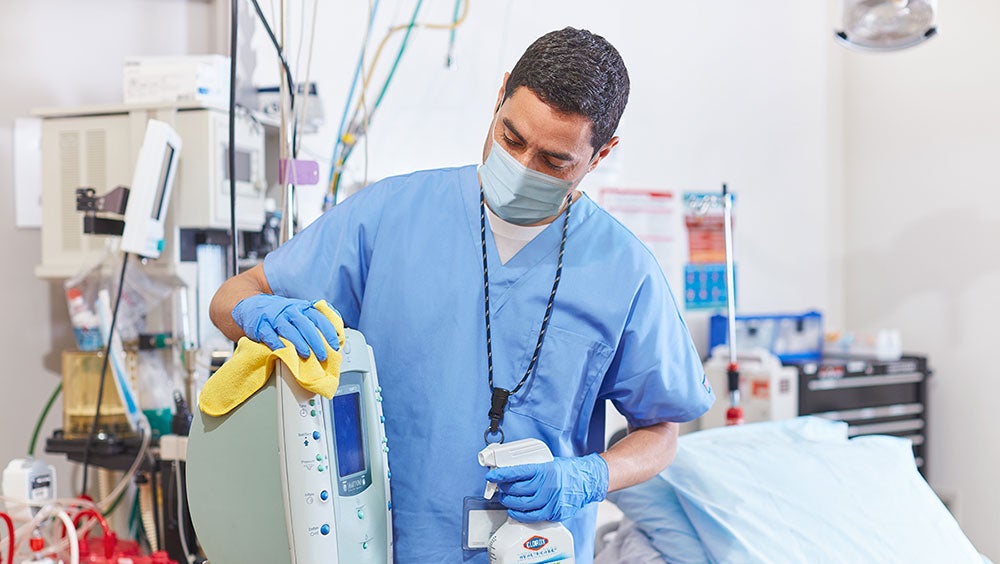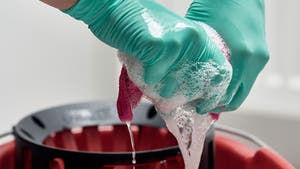Pandemic Preparedness and Environmental Disinfection: Proper Identification of Disinfectant Alternatives During a Pandemic Crisis
The COVID-19 pandemic has created unprecedented and continuing difficulties for healthcare providers, health systems, and patients alike. With any novel pathogen such as SARS-CoV-2, the virus that causes COVID-19, public health professionals, and healthcare providers continuously evolve their approach to the pandemic response. During times of increased focus on certain infection control practices such as hand hygiene agents and environmental disinfectants, challenges to the supply chain can rapidly emerge. Still, they can be addressed by implementing a robust pandemic response plan to facilitate appropriate product substitutions.

The Centers for Disease Control and Prevention (CDC) and the Environmental Protection Agency (EPA) have released extensive guidance regarding the use of EPA-registered disinfectants during the ongoing COVID-19 pandemic. In addition, the EPA created a specific list, List N. Disinfectants for Coronavirus (COVID-19). This is a list of EPA-registered disinfectants that are deemed effective against SARS-CoV-2. The use of products on this validated list from the EPA provides healthcare users an additional level of assurance of efficacy against the virus that causes COVID-19.
Many disinfectant manufacturers offer the same active ingredient formulations in multiple product formats (ready-to-use wipes, liquids, sprays, etc.), which can mitigate any significant impacts for healthcare facilities during pandemic scenarios. Similar to stockpiling certain medical equipment and supplies such as Personal Protective Equipment (PPE), it would be advisable for healthcare facilities to have a comprehensive pandemic plan in place to address increased environmental disinfection needs across the healthcare continuum of care.
Analogous to the CDC’s approach to the use of PPE, a comparable process can easily be created for identifying appropriate disinfectant product substitutes during a pandemic crisis. As such, a three-tiered approach can be implemented to include:
- Conventional Capacity: During this phase, general infection control and prevention strategies can be utilized, and normal disinfectants would be used.
- Contingency Capacity: During this phase, due to supply chain challenges, alternate disinfectant product formats or formulations should be considered after careful evaluation. For example, if a healthcare facility is using ready-to-use disinfecting wipes as the primary means for facility disinfection, it would be feasible to use the same formulation’s alternate product formats such as ready-to-use sprays or liquids as an acceptable alternative. If neither of these is available, it may be necessary to switch to a concentrated disinfectant (liquid) that requires dilution but is still the same active ingredient.
- Crisis Capacity: During this phase, the healthcare supply chain experiences ongoing and substantial supply chain disruptions. As such, healthcare facilities may be forced to use any EPA-registered disinfectant that is able to be obtained or use other product formats that require mixing or advanced application techniques. Healthcare leaders should plan accordingly and be proactive in their approach to ensure continuity of product supply chain.
When selecting product substitutes, healthcare users should consult the EPA’s master label for the product being evaluated, review any technical information on surface compatibility, as well as carefully review the product’s Safety Data Sheet (SDS). The intended location of use for the product can also impact the ideal product to be used such as inpatient vs. outpatient settings where risks would be substantially different. Certain inert or inactive ingredients, for example, may increase the risk for equipment degradation, so healthcare users should contact the disinfectant manufacturers and request a complete listing of all product ingredients and information on known equipment compatibility with commonly found surfaces and medical devices used in healthcare settings. Healthcare users of disinfectants should also consult the product instructional manual from the medical equipment manufacturer for specific cleaning and disinfection instructions.
When forced to select alternative disinfectants or disinfectant chemistries, Infection Preventionists and Environmental Services Leaders should evaluate these substitutes in terms of three primary criteria:
- Efficacy: Does the product inactivate pathogens?
- Safety: Is this product safe for the healthcare user and for use around the patient in an occupied room?
- Compatibility: Does the use of the product compromise the surface integrity or aesthetics?
The COVID-19 pandemic continues to place significant strains on our healthcare systems and providers. Infection control practices such as disinfection, hand hygiene, and the appropriate use of PPE remain important aspects of decreasing the spread of SARS-CoV-2. Disinfectant manufacturers are the primary sources of expertise in the areas of product formulation, product format, contact times, material compatibility, and product safety. Infection Preventionists and EVS Leaders should closely collaborate with their preferred disinfectant manufacturer and medical suppliers on pandemic preparedness needs and the most appropriate product substitutions.
Moreover, many disinfectant manufacturers have created product substitution tools that can help ensure that all new products utilized within a facility will continue to meet the stringent infection control needs as identified by the Infection Prevention and Control Team. Pandemics require a collaborative, transparent, and highly communicative approach to overcome their impacts. While the healthcare industry continues to face challenges, it is certainly possible to maintain a safe standard of care related to environmental cleaning and disinfection by following a standardized approach.
For additional information:
- Interim Infection Prevention and Control Recommendations for Healthcare Personnel During the Coronavirus Disease 2019 (COVID-19) Pandemic. Electronically accessed from: https://www.cdc.gov/coronavirus/2019-ncov/hcp/infection-control-recommendations.html.
- U.S. Environmental Protection Agency. Can I apply a product using a method that is not specified in the directions for use? Electronically accessed from: https://www.epa.gov/coronavirus/can-i-apply-product-using-method-not-specified-directions-use.
- U.S. Environmental Protection Agency. Disinfectant use and Coronavirus (COVID-19). Electronically accessed from: https://www.epa.gov/coronavirus/disinfectant-use-and-coronavirus-covid-19.
Dr. Hudson Garrett Jr. is a paid consultant for Clorox Healthcare.


